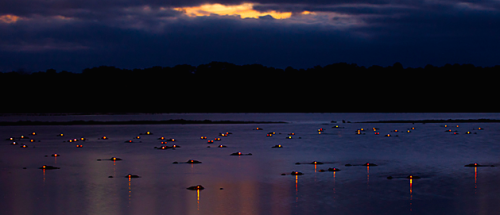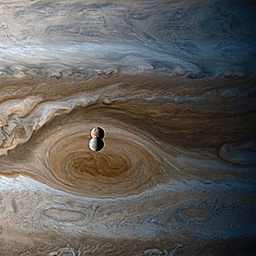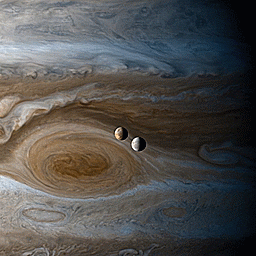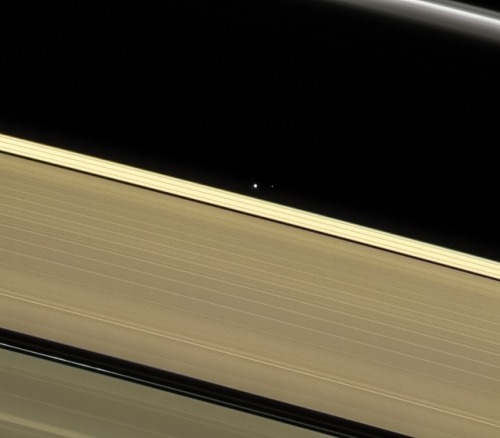“Cassini's Own Discoveries Were Its Demise.”
“Cassini's own discoveries were its demise.”
– Earl Maize, its project engineer @ JPL
current mood: emotional about a space probe
Cassini is the first spacecraft that was destroyed not from malfunction, or as a necessary end result of its mission… but out of love.
The probe was running out of propulsion fuel, but there’s no reason it couldn’t have been pushed into a stable orbit from where it could collect data and send back pictures for a long while yet.
Except it had detected that one of Saturn’s moons held liquid water and organic compounds: a world that might support life. A world that is, at the least, dreaming of life.
There is no orbit stable enough to be certain that the probe, carrying radioactive batteries and Earth’s bacteria, would never have come into contact with Enceladus. A delicate island of alien life could have been snuffed out or overrun. The sheep could have eaten the rose.
So instead - for the love of this fragile possibility, this potential that might yet never be realized - Cassini was brought into a final, intimate tango with Saturn.
But of course, all space probes are built for the sake of awe, which is nearly love. Science is rational, but scientists are driven to understand the universe just as the religious strive to know the face of God.
The Cassini probe was a 4 billion dollar machine for understanding Saturn. And yesterday, two decades after it launched from our planet, it was destroyed while sending us information about Saturn it never could have gathered from a distant, stable orbit: advancing its purpose, even though it would be consumed.
More Posts from Starry-shores and Others
My God, it’s full of stars
- Dave Bowman, 2001 a Space Odyssey
When you look up from a dark site on a clear moonless night, the sky appears full of stars, almost too many to count.
It turns out that, with the naked eye, one can see anywhere between 5000 to 10000 stars, depending on whom you ask and how they estimate this number and just half of that on a given night because the Earth gets in your way. Still a lot but really nothing when you consider there are billions - maybe hundreds of billions of stars in our Galaxy and trillions of galaxies in the Universe.
It’s a completely different matter when you use optical aid. A pair of 50 mm binoculars can pull in some hundreds of thousands of stars; a small - say 80 mm telescope - like mine-can “ see” millions.
And here is an example. This is the much loved deep southern object known familiarly as 47 Tucanae- Tuc 47 to friends- and it is what is known as a globular cluster.
It contains over a million stars - I am unable to determine what the latest estimate is- a couple of decades ago we used to say it contained half a million stars but that estimate has since been upped.
It’s the second largest of this type of cluster- there are around 150 of these distributed in a halo around our galaxy that we know of.
And quite spectacular in a telescope of any size. It cannot but bring to mind Dave Bowman’s famous exclamation in “2001 a Space Odyssey “
Imaged from my backyard last weekend; an image salvaged despite the usual trials and tribulations that beset the amateur astrophotographer including tangled cables and the camera slamming into the tripod leg and so on and so forth.
Given the long weather forecast it’s going to be slim pickings this summer so you take what you get
What would it be like to live on a planet within a globular cluster? In 1941 Issac Asimov wrote a great short story “ Nightfall “ imagining just that. Highly recommended if you have forgotten it
Sadly the Hubble Space Telescope looked for planets in Tuc 47… and found none. So we have no evidence that planets form within these globular clusters- thus far
https://flic.kr/p/2mGS9cC

Cover design for an Italian reprint of Isaac Asimov’s “Foundation Trilogy” by Gabriel Björk Stiernström.
⦕⁅⁅⁅ɔ ⦕⁅⁅⁅ɔ ⦕⁅⁅⁅ɔ ⦕⁅⁅⁅ɔ ⦕⁅⁅⁅ɔ
you have encountered a group of trilobites! reblog to help them on their journey
Hiking to the largest Ammonite in the world!
Video description:
Titanites lived during the Late Jurassic Period and had a shell diameter of around 137 centimetres! surprisingly it wasn’t the largest ammonoid, as some species such as Parapuzosia could get over twice as large!
There were also some plant fossils around the area of this site!





the red eyeshine of the alligator occurs when light enters its eyes, passes through the rods (light receptors) and cones (color receptors) of the retina, strikes a membrane behind the retina called a tapeatum, and is then reflected back through the eye to the light source. most of the animals with eyeshine are, like alligators, night hunters who must make use of limited light. photos by larry lynch and david moynahan
cosiscience
Walking dinosaur, Columbus Interactive Science Museum
-
 bambi666 liked this · 2 months ago
bambi666 liked this · 2 months ago -
 facetowardsthedawn-blog reblogged this · 4 months ago
facetowardsthedawn-blog reblogged this · 4 months ago -
 kaysper reblogged this · 6 months ago
kaysper reblogged this · 6 months ago -
 jaci-sees liked this · 9 months ago
jaci-sees liked this · 9 months ago -
 sejoo reblogged this · 10 months ago
sejoo reblogged this · 10 months ago -
 sejoo liked this · 10 months ago
sejoo liked this · 10 months ago -
 pleasanttrashdinosaur reblogged this · 1 year ago
pleasanttrashdinosaur reblogged this · 1 year ago -
 pleasanttrashdinosaur liked this · 1 year ago
pleasanttrashdinosaur liked this · 1 year ago -
 papallion reblogged this · 1 year ago
papallion reblogged this · 1 year ago -
 papallion liked this · 1 year ago
papallion liked this · 1 year ago -
 shalings liked this · 1 year ago
shalings liked this · 1 year ago -
 lightandwinged reblogged this · 1 year ago
lightandwinged reblogged this · 1 year ago -
 5hps reblogged this · 1 year ago
5hps reblogged this · 1 year ago -
 wolffyluna liked this · 1 year ago
wolffyluna liked this · 1 year ago -
 saphicspacesociety17 reblogged this · 1 year ago
saphicspacesociety17 reblogged this · 1 year ago -
 pyrot3ch-nick liked this · 1 year ago
pyrot3ch-nick liked this · 1 year ago -
 kaltehertz reblogged this · 1 year ago
kaltehertz reblogged this · 1 year ago -
 wristexplosion reblogged this · 1 year ago
wristexplosion reblogged this · 1 year ago -
 coldmail750 liked this · 1 year ago
coldmail750 liked this · 1 year ago -
 freelyjoyfultrash reblogged this · 1 year ago
freelyjoyfultrash reblogged this · 1 year ago -
 freelyjoyfultrash liked this · 1 year ago
freelyjoyfultrash liked this · 1 year ago -
 zabrefang reblogged this · 1 year ago
zabrefang reblogged this · 1 year ago -
 ghost-avian reblogged this · 1 year ago
ghost-avian reblogged this · 1 year ago -
 ghost-avian liked this · 1 year ago
ghost-avian liked this · 1 year ago -
 kinsey3furry300 reblogged this · 1 year ago
kinsey3furry300 reblogged this · 1 year ago -
 kinsey3furry300 liked this · 1 year ago
kinsey3furry300 liked this · 1 year ago -
 bigredbang liked this · 1 year ago
bigredbang liked this · 1 year ago -
 aristhought liked this · 1 year ago
aristhought liked this · 1 year ago -
 medinaquirin reblogged this · 1 year ago
medinaquirin reblogged this · 1 year ago -
 medinaquirin liked this · 1 year ago
medinaquirin liked this · 1 year ago -
 gallifreanpotterhead reblogged this · 1 year ago
gallifreanpotterhead reblogged this · 1 year ago -
 renniejoy reblogged this · 1 year ago
renniejoy reblogged this · 1 year ago -
 renniejoy liked this · 1 year ago
renniejoy liked this · 1 year ago -
 rationalfears reblogged this · 1 year ago
rationalfears reblogged this · 1 year ago -
 taiey reblogged this · 1 year ago
taiey reblogged this · 1 year ago -
 belladonna-and-the-sweetpeas reblogged this · 1 year ago
belladonna-and-the-sweetpeas reblogged this · 1 year ago -
 lu-sn liked this · 1 year ago
lu-sn liked this · 1 year ago -
 chalkrevelations reblogged this · 1 year ago
chalkrevelations reblogged this · 1 year ago -
 elmuertoqueparla reblogged this · 1 year ago
elmuertoqueparla reblogged this · 1 year ago -
 sublimenemesis liked this · 1 year ago
sublimenemesis liked this · 1 year ago -
 hobok liked this · 1 year ago
hobok liked this · 1 year ago -
 noatwithstanding liked this · 1 year ago
noatwithstanding liked this · 1 year ago -
 mos27 reblogged this · 1 year ago
mos27 reblogged this · 1 year ago -
 nonsemsical reblogged this · 1 year ago
nonsemsical reblogged this · 1 year ago -
 nonsemsical liked this · 1 year ago
nonsemsical liked this · 1 year ago -
 caranthira reblogged this · 1 year ago
caranthira reblogged this · 1 year ago -
 tehluggage liked this · 1 year ago
tehluggage liked this · 1 year ago -
 akaanir-of-starfleet reblogged this · 2 years ago
akaanir-of-starfleet reblogged this · 2 years ago

Amateur astronomer, owns a telescope. This is a side blog to satiate my science-y cravings! I haven't yet mustered the courage to put up my personal astro-stuff here. Main blog : @an-abyss-called-life
212 posts





